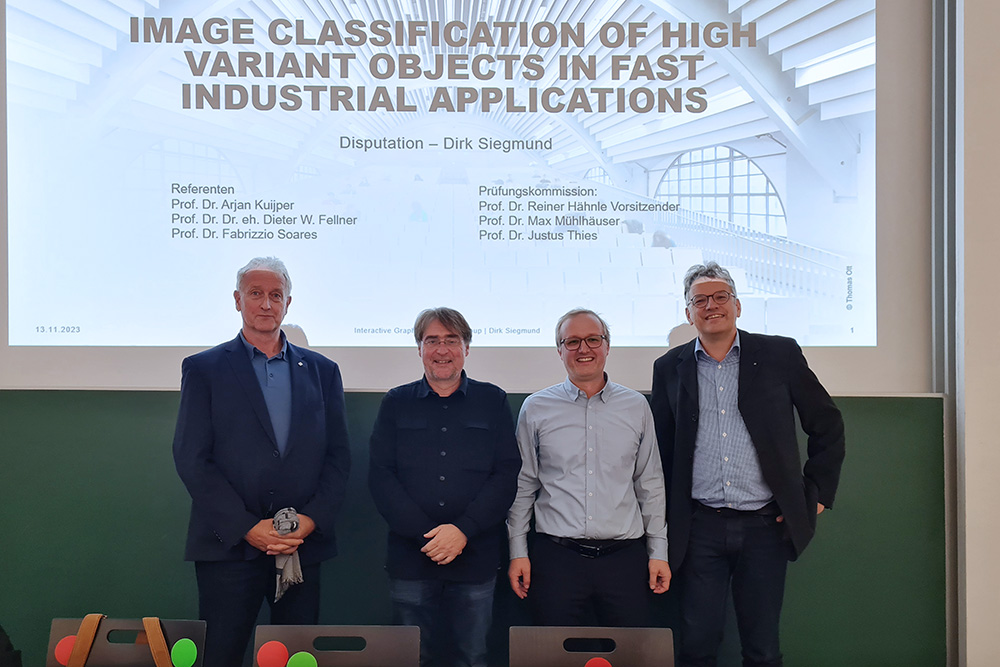Promotion of Dirk Siegmund
Congratulations! Dirk Siegmund, former long-time employee in the "Smart Living & Biometric Technologies" competence center, successfully defended his dissertation "Image Classification of High Variant Objects in Fast Industrial Applications" on November 13, 2023. The reviewers of the thesis were Prof. Dr. Arjan Kuijper (TU Darmstadt/Fraunhofer IGD), Prof. Dr.-Ing. Dieter W. Fellner (TU Darmstadt/Fraunhofer IGD), and Prof. Dr. Fabrizzio Soares (Universidade Federal de Goiás).
In 2020, Dirk Siegmund founded a spin-off of Fraunhofer IGD called Desion GmbH and currently serves as its CEO. The company specializes in visual inspections for various applications involving textiles in different conditions.
Abstract
Recent advances in machine learning and image processing have expanded the applications of computer vision in many industries. In industrial applications, image classification is a crucial task since high variant objects present difficult problems because of their variety and constant change in attributes. Computer vision algorithms can function effectively in complex environments, working alongside human operators to enhance efficiency and data accuracy. However, there are still many industries facing difficulties with automation that have not yet been properly solved and put into practice. They have the need for more accurate, convenient, and faster methods. These solutions drove my interest in combining multiple learning strategies as well as sensors and image formats to enable the use of computer vision for these applications. The motivation for this work is to answer a number of research questions that aim to mitigate current problems in hinder their practical application. This work therefore aims to present solutions that contribute to enabling these solutions. I demonstrate why standard methods cannot simply be applied to an existing problem. Each method must be customized to the specific application scenario
in order to obtain a working solution.
One example is face recognition where the classification performance is crucial for the system’s ability to correctly identify individuals. Additional features would allow higher accuracy, robustness, safety, and make presentation attacks more difficult. The detection of attempted attacks is critical for the acceptance of such systems and significantly impacts the applicability of biometrics. Another application is tailgating detection at automated entrance gates. Especially in high security environments it is important to prevent that authorized persons can take an unauthorized person into the secured area. There is a plethora of technology that seem potentially suitable but there are several practical factors to consider that increase or decrease applicability depending which method is used. The third application covered in this thesis is the classification of textiles when they are not spread out. Finding certain properties on them is complex, as these properties might be inside a fold, or differ in appearance because of shadows and position.
The first part of this work provides in-depth analysis of the three individual applications, including background information that is needed to understand the research topic and its proposed solutions. It includes the state of the art in the area for all researched applications. In the second part of this work, methods are presented to facilitate or enable the industrial applicability of the presented applications. New image databases are initially presented for all three application areas. In the case of biometrics, three methods that identify and improve specific performance parameters are shown. It will be shown how melanin face pigmentation (MFP) features can be extracted and used for classification in face recognition and PAD applications. In the entrance control application, the focus is on the sensor information with six methods being presented in detail. This includes the use of thermal images to detect humans based on their body heat, depth images in form of RGB-D images and 2D image series, as well as data of a floor mounted sensor-grid. For textile defect detection several methods and a novel classification procedure, in free-fall is presented.
In summary, this work examines computer vision applications for their practical industrial applicability and presents solutions to mitigate the identified problems. In contrast to previous work, the proposed approaches are
(a) effective in improving classification performance (b) fast in execution and (c) easily integrated into existing processes and equipment.
 Fraunhofer Institute for Computer Graphics Research IGD
Fraunhofer Institute for Computer Graphics Research IGD
